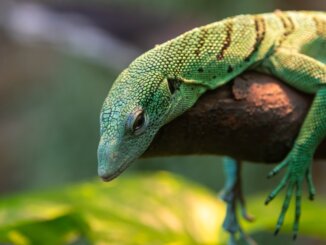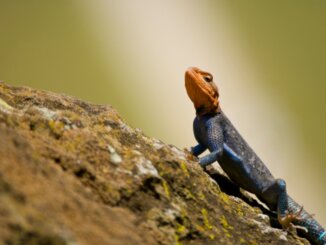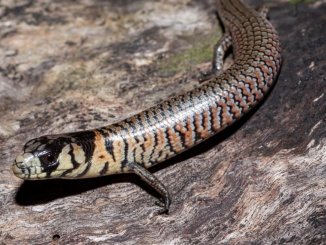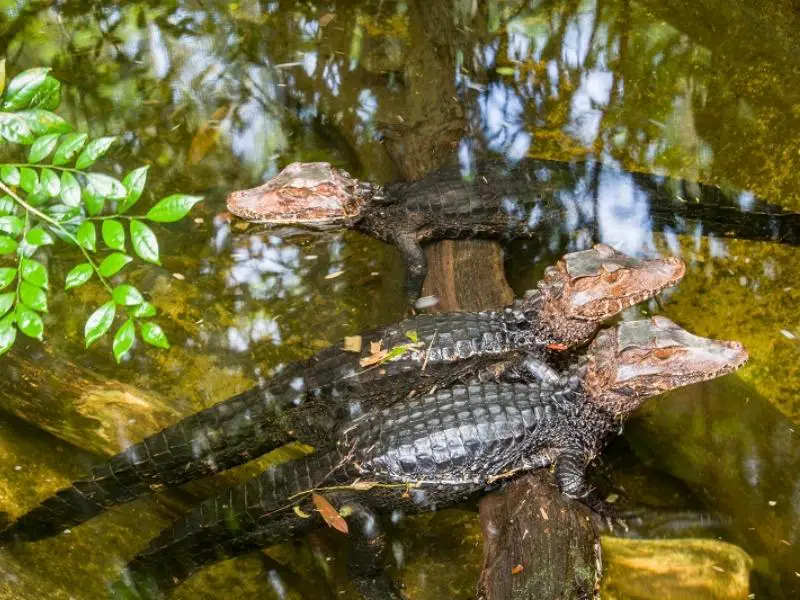
The dwarf caiman is a small crocodilian species hailing from forested riverine habitats in northern and central South America.
Caring for dwarf caimans is moderately difficult. This species is the smallest type of crocodilian, but it still takes up a lot of space and needs a large enclosure and a lot of food.
Dwarf Caiman Overview
| Common name | Dwarf Caiman Overview |
| Scientific name | Paleosuchus palpebrosus |
| Natural habitat | Areas of flooded forest around lakes and forested riverine habitats in regions in central and northern South America |
| Adult size | 45–62 inches |
| Average lifespan | Up to 25 years |
| Diet | Carnivore |
| Housing | Carnivore |
| Experience | Intermediate to expert |
Origin
The dwarf caiman (Paleosuchus palpebrosus) originates in warm, humid habitats with an abundant source of freshwater (such as streams, lakes, rivers, and floodland). The crocodilian is found across regions in central and northern South America, including Brazil, Bolivia, Colombia, Ecuador, French Guiana, Guyana, Paraguay, Peru, Suriname, Trinidad, and Venezuela.
In their wild habitat, dwarf caimans spend most of their time submerged underwater. The crocodilians can traverse dry land to travel between bodies of water. They feed on both water-dwelling species (such as fish and crabs) and land-dwelling animals (such as birds and small mammals). Caimans are nocturnal and sleep in burrows built into tree roots during the day.
Dwarf caimans are threatened by habitat destruction and pollution.
Appearance and Behavior
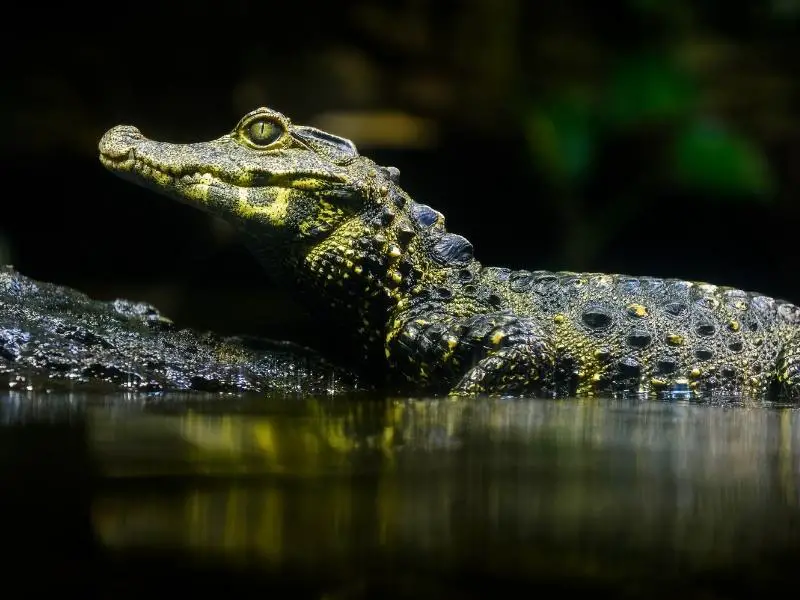
The dwarf caiman is a small crocodilian with a dark brown or black body, a dome-shaped skull, a slender neck, and chestnut brown eyes with slit-like pupils. The crocodilian’s head shape resembles a dog’s, with a concave snout and an upturned lip, with an upper jaw that extends further than the lower jaw, revealing a row of sharply-pointed teeth.
Dwarf caimans have thick, leathery skin, covered with pale spots and stripes, that acts as armor. Their eyes are located at the top of their heads, enabling them to keep their bodies submerged underwater while still being able to see above the surface. The dwarf caiman has enlarged scales near its eyes and the tail, known as scutes, and rigid scales on its back and belly.
Size and Lifespan
The dwarf caiman is smaller than its fellow crocodilians, with an average length of 45–62 inches and an average weight of 11–15 pounds.
Male and female dwarf caimans can be differentiated by weight and size. Males are about 3 pounds heavier and 12–24 inches longer than females.
Most dwarf caimans live for around 25 years. In the wild, some crocodilians of this species live up to 40 years. In captivity, in optimal living conditions with top-notch husbandry, a dwarf caiman may live up to 60 years.
Temperament
The dwarf caiman is a social but territorial species that prefers to live alone. This crocodilian has an aggressive personality and should only be handled by someone with experience looking after a large, temperamental reptile species.
A dwarf caiman’s bite can cause serious injury, and it’s difficult to open the crocodilian’s jaws once they’re closed. These reptiles never become tame, so they should be appreciated from behind the walls of their enclosure. Families with children should address the safety concerns of owning a dwarf caiman prior to buying this species.
Housing Dwarf Caimans
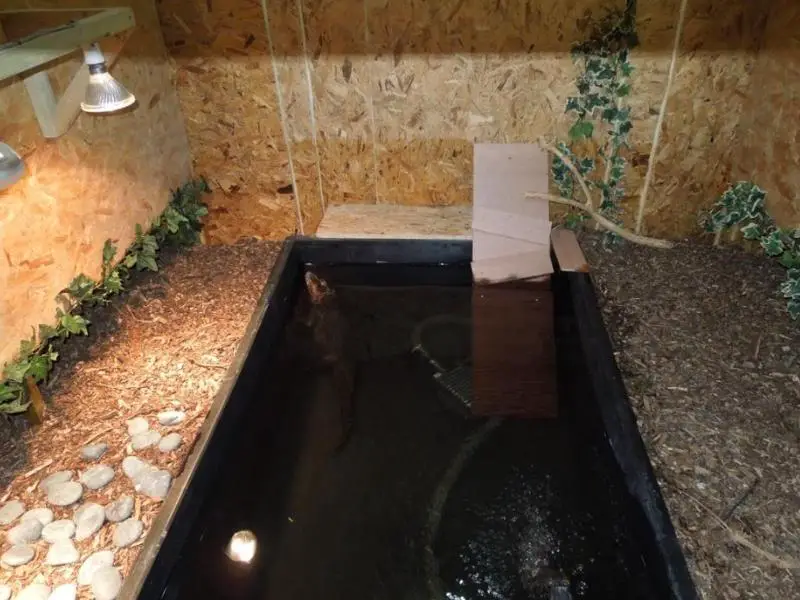
The dwarf caiman’s natural habitat is freshwater streams and lakes in hot, humid woodlands spanning central and northern South America. Mimic this environment in the crocodilian’s enclosure to prevent stress and disease.
Keep dwarf caimans in a large glass or PVC aquarium.
Enclosure size
The ideal enclosure size for a dwarf caiman is at least 50 gallons for a juvenile and at least 100 gallons for an adult. The larger the enclosure, the better — a 300-gallon enclosure is about ideal. You need plenty of space to house this large reptile species, and many dwarf caiman enclosures need to be custom-built.
To accommodate a dwarf caiman, your enclosure should be at least 180 inches long and 100 inches wide. Dwarf caimans don’t climb, but the enclosure should be partly filled with water, so the ideal enclosure height is 96 inches.
Lighting
Dwarf caimans are nocturnal, but they still need access to daylight to regulate their day-to-night cycle, and UV light source for basking.
Building the enclosure in a room with a window should provide enough natural sunlight to keep your dwarf caiman healthy. Make sure the enclosure doesn’t get direct sunlight, which could cause overheating and promote algae growth.
Install a UVB bulb in the basking area in the enclosure. UVB enables dwarf caimans to produce vitamin D3 for proper calcium absorption from food. Without UVB, a crocodilian of this species could have lowered immunity and other health problems.
Temperature
The dwarf caiman is accustomed to living in a warm climate, and the enclosure temperature should replicate the reptile’s natural habitat as closely as possible.
Provide a temperature gradient in the enclosure, allowing the dwarf caiman to move between warm and cool areas to regulate its body temperature. The basking area should be heated to 90°F. You can use a 125–150-watt heat lamp or a heating pad to achieve this.
The cooler area of the enclosure should have a temperature of around 80°F. You shouldn’t need a separate heater — the basking lamp should provide enough heat for the entire enclosure.
The temperature of the water in the enclosure should remain at 72°F. You can monitor and control water temperature with a submersible aquarium heater.
60%–70% humidity is ideal for a dwarf caiman enclosure. The water in the enclosure should provide enough humidity without the need for additional measures. Use a hygrometer to measure humidity and adjust if needed.
Substrate and Decoration
Your dwarf caiman enclosure should have two main sections: a terrestrial area (mainly for basking) and an area of water (mainly for swimming).
Line the terrestrial area with a moisture-holding substrate, like moss, rocks, bark, or mulch. Choose a soft, non-abrasive substrate because dwarf caimans enjoy digging and burrowing in the ground. To reduce the need for cleaning and maintenance, use gravel to line the ground surrounding the water area.
Provide a deep pool of clean, warm water for this freshwater species to swim in. Install a high-quality filtration system to keep the water clean and prevent bacteria growth. Litter the pool with rocks of varying sizes and large logs, ensuring there’s plenty of space for swimming.
Dwarf caimans are a nervous species and are known to have feeding problems if they don’t have adequate places to hide. Provide caves, tunnels, and shaded spots beneath large plants for the reptiles to relax and sleep in.
Live and artificial plants are a good addition to a dwarf caiman enclosure. Choose sturdy, thick-rooted, heat- and humidity-tolerant plants like maranta, orchids, ferns, and mosses.
Make sure all decorations in the enclosure are secured to the floor to prevent them from being buried or knocked over by the dwarf caiman. Conceal cables and cords inside ceramic pots or underneath large rocks.
Cleaning
Cleaning a dwarf caiman enclosure is a big task because of the enclosure’s large size. To minimize your cleaning duties, reduce the furnishings and decorations in the tank, only providing the necessary items.
Spot-clean the enclosure by removing feces and uneaten food once a day.
Clean the enclosure once a week by completing the following tasks:
- Change or clean sections of the soiled substrate
- Wipe down the leaves of plants and wash removable decorations
- Use a bucket to remove the protein layer from the top of the water
- Clean the glass with equal parts water and white vinegar
By keeping on top of regular cleaning, you should never have to complete an extensive, time-consuming deep clean.
Before cleaning, transfer the dwarf caiman into a separate enclosure using a large net or a cage.
Dwarf Caiman Care
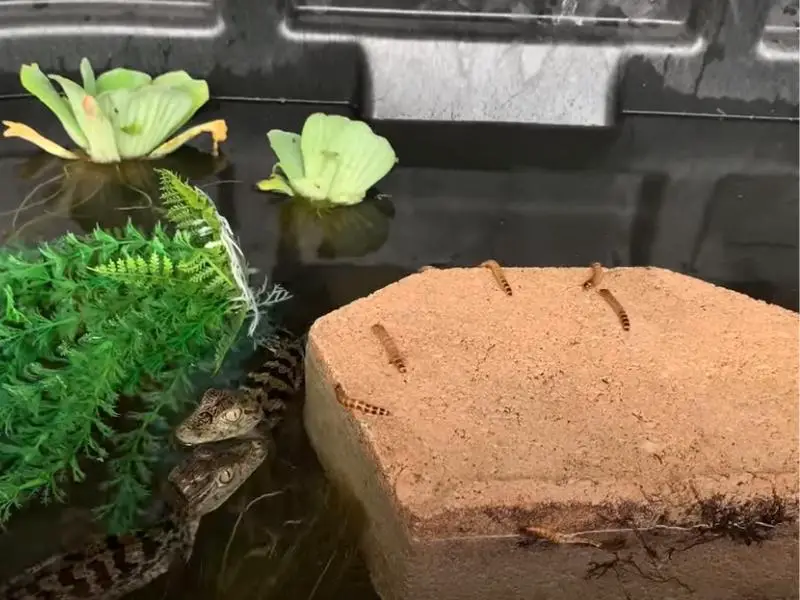
Dwarf caimans are moderately difficult to look after in captivity and should be cared for by an experienced reptile keeper. The crocodilians have big appetites and are prone to several health conditions (usually resulting from poor husbandry).
Food and Water
In the wild, the dwarf caiman eats a carnivorous diet of large fish, amphibians, and invertebrates. Juveniles eat fewer fish, but more invertebrates and frogs, compared to adults. Provide a similarly varied diet in captivity to ensure the reptile’s nutritional needs are all met.
Frozen and thawed birds and rodents are good protein-rich foods for dwarf caimans in captivity. Ensure the food is pre-killed, not live, to prevent safety issues concerning the caiman and the person feeding it.
Feed your dwarf caiman every three to four days, depending on their rate of growth. Check that you’re not under or overfeeding the crocodilian by observing the neck, the tail base, and the abdomen. These areas shouldn’t look hollow or bulge.
To support the digestion of a hatchling and young dwarf caiman, chop or mince whole prey items and feed them to your caiman on a plate.
Handling
Dwarf caimans are aggressive, snappy, and temperamental, so they shouldn’t be handled unless absolutely necessary.
Don’t directly hold a dwarf caiman in your hands. Guide the crocodilian into a cage or a deep, sturdy net while it’s in the enclosure, then carefully transfer it to the desired location, keeping your hands well away from the caiman’s jaws.
For health checkups, contact your local exotic species veterinarian, who should have processes in place for safely examining potentially dangerous animals.
Common Health Issues
Dwarf caimans have a number of specific needs that should be met to prevent health issues and stress. Some of the potential health problems affecting this crocodilian species are listed below.
Respiratory Infections and Diseases
Bacteria, viruses, and fungi in an enclosure can cause respiratory infections and diseases in a dwarf caiman. Symptoms of respiratory issues include shallow breathing, discharge from the mouth or nose, lethargy, appetite loss, weakness, and abnormal behavior. Respiratory problems caused by bacteria are treated with antibiotics. Other medications are used to treat respiratory diseases caused by viruses and fungi.
Hypothermia
Failing to maintain warm water and enclosure temperatures may cause your dwarf caiman to contract hypothermia. Symptoms of hypothermia in reptiles include unusual side-to-side movements during swimming, lethargy, appetite loss, and decreased activity. A dwarf caiman with severe hypothermia may drown. Treat hypothermia by immediately increasing the enclosure’s air and water temperature to an optimal range. Arrange a checkup appointment with your veterinarian as soon as possible.
Skin Infections
If you notice your dwarf caiman excessively scratching its body with its hind legs, it may be suffering from a skin infection. Poor water quality, an unclean enclosure, stress, and parasites are all common causes of skin infections in reptiles. Aside from itching, other symptoms of skin infections are a rash, blisters, and other skin abnormalities. Treat skin infections with medications recommended by your veterinarian and prevent dermatological issues by maintaining an appropriate enclosure climate and adequate cleanliness.
Breeding
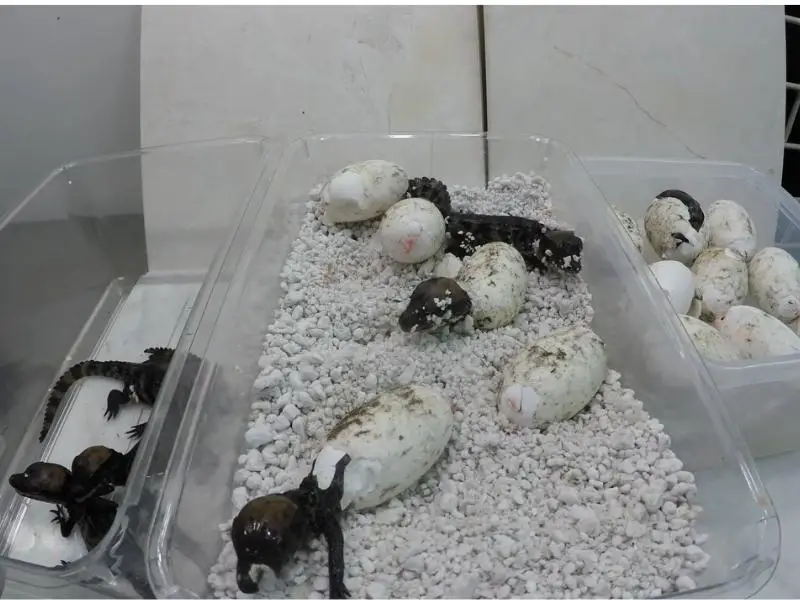
In the wild, dwarf caimans mate near shallow waters in a process that lasts between five and ten minutes. Females reach sexual maturity at about eight years old, and males are sexually mature by six years old. Females can only breed once per year.
Breeding takes place in the rainy season, and females construct mound nests in preparation for egg-laying.
Most females lay between 10 and 20 eggs. Incubation time is between 100 and 115 days. The hatchlings emerge from the eggs as the water levels rise due to the rain.
Due to the dwarf caiman’s large size and aggressive nature, breeding this crocodilian in captivity isn’t recommended. Little information is available on how to successfully breed dwarf caimans in a captive environment, and breeding should only be attempted by reptile experts.
Choosing and Buying a Dwarf Caiman
The cost of a hatchling dwarf caiman is $200 to $400. You can buy this caiman species from breeders and exotic pet stores. For the highest likelihood of finding a healthy, well-raised dwarf caiman, research breeders online.
Keep in mind that the cost of raising a dwarf caiman is much higher than the cost of raising most reptiles, due to the caiman’s large size and long lifespan. Before you buy this species, make sure you’re prepared to spend thousands of dollars to care for your crocodilian throughout its lifespan.
Avoid wild-caught dwarf caimans, which are more prone to health problems and injuries than captive-bred caimans. Ask to see the caiman in person before you spend your money. Check that the crocodilian has healthy eating and swimming habits, clear eyes, and alert behaviors. Don’t buy a dwarf caiman that exhibits any signs of poor health, including weakness, lethargy, anorexia, cuts, mucus around the eyes or nose, and skin lesions.

